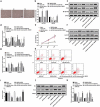Upregulation of microRNA-204 improves insulin resistance of polycystic ovarian syndrome via inhibition of HMGB1 and the inactivation of the TLR4/NF-κB pathway
- PMID: 32089069
- PMCID: PMC7145337
- DOI: 10.1080/15384101.2020.1724601
Upregulation of microRNA-204 improves insulin resistance of polycystic ovarian syndrome via inhibition of HMGB1 and the inactivation of the TLR4/NF-κB pathway
Retraction in
-
Statement of Retraction: Upregulation of microRNA-204 improves insulin resistance of polycystic ovarian syndrome via inhibition of HMGB1 and the inactivation of the TLR4/NF-κB pathway.Cell Cycle. 2022 Apr;21(8):878. doi: 10.1080/15384101.2022.2046820. Epub 2022 Mar 17. Cell Cycle. 2022. PMID: 35297296 Free PMC article. No abstract available.
Abstract
There is growing evidence of the position of microRNAs (miRs) in polycystic ovarian syndrome (PCOS), thus our objective was to discuss the impact of miR-204 on insulin resistance (IR) in PCOS by targeting highmobility group box protein 1(HMGB1)-mediated toll-like receptor 4(TLR4)/nuclear factor-kappa B (NF-κB) pathway.PCOS-IR patients and PCOS non-insulin resistance (PCOS-NIR) patients were included. The levels of serum sex hormones and related insulin were measured, the expression of miR-204, HMGB1, TLR4 and NF-κB p65 was detected, the diagnostic efficacy of miR-204 in PCOS-IR was analyzed, and the correlation between the expression of miR-204 in PCOS-IR and fasting blood glucose (FPG), fasting insulin (FINS), homeostasis model of assessment for insulin resistance index (HOMA-IR) was analyzed. Both in vitro and in vivo experiments were performed to elucidate the capabilities of miR-204 and HMGB1 in proliferation and apoptosis of PCOS-IR granulosa cells.MiR-204 was lowly expressed as well as HMGB1, TLR4 and NF-κB p65 were highly expressed in PCOS-IR patients. Follicule-stimulating hormone was downregulated, while luteinizing hormone, estrogen, progesterone, FPG, FINS and HOMA-IR were elevated in PCOS-IR. Upregulation of miR-204 and downregulation of HMGB1 could repress TLR4/NF-κB pathway activation, degraded insulin release and testosterone (T) leveland ascended ovarian coefficient, boosted cell proliferation and restrained apoptosis of granulosa cells. Overexpression of HMGB1 reverses the effect of upregulation of miR-204 on IR of PCOS.Our study presents that high expression of miR-204 or inhibition of HMGB1 can improve IR of PCOS via the inactivation of TLR4/NF-κB pathway.
Keywords: HMGB1; Polycystic ovarian syndrome; TLR4/NF-κB pathway; microRNA-204.
Figures





Similar articles
-
Cryptotanshinone alleviates polycystic ovary syndrome in rats by regulating the HMGB1/TLR4/NF‑κB signaling pathway.Mol Med Rep. 2020 Nov;22(5):3851-3861. doi: 10.3892/mmr.2020.11469. Epub 2020 Aug 28. Mol Med Rep. 2020. PMID: 32901834 Free PMC article.
-
Ghrelin Alleviates Inflammation, Insulin Resistance, and Reproductive Abnormalities in Mice with Polycystic Ovary Syndrome via the TLR4-NF-κB Signaling Pathway.Discov Med. 2024 May;36(184):946-958. doi: 10.24976/Discov.Med.202436184.88. Discov Med. 2024. PMID: 38798254
-
Downregulation of lncRNA ZFAS1 and upregulation of microRNA-129 repress endocrine disturbance, increase proliferation and inhibit apoptosis of ovarian granulosa cells in polycystic ovarian syndrome by downregulating HMGB1.Genomics. 2020 Sep;112(5):3597-3608. doi: 10.1016/j.ygeno.2020.04.011. Epub 2020 Apr 19. Genomics. 2020. PMID: 32320818
-
Insights on the NF-κB system in polycystic ovary syndrome, attractive therapeutic targets.Mol Cell Biochem. 2024 Mar;479(3):467-486. doi: 10.1007/s11010-023-04736-w. Epub 2023 Apr 25. Mol Cell Biochem. 2024. PMID: 37097332 Review.
-
MicroRNAs as Biomarkers for Metabolic Disorders in Polycystic Ovary Syndrome (PCOS): A Review.Med Sci Monit. 2024 Dec 22;30:e946480. doi: 10.12659/MSM.946480. Med Sci Monit. 2024. PMID: 39709519 Free PMC article. Review.
Cited by
-
Regulatory mechanisms of HMGB1 and its receptors in polycystic ovary syndrome-driven gravid uterine inflammation.FEBS J. 2023 Apr;290(7):1874-1906. doi: 10.1111/febs.16678. Epub 2022 Dec 8. FEBS J. 2023. PMID: 36380688 Free PMC article.
-
Identification of Bioactive Compounds and Potential Mechanisms of Kuntai Capsule in the Treatment of Polycystic Ovary Syndrome by Integrating Network Pharmacology and Bioinformatics.Oxid Med Cell Longev. 2022 Apr 28;2022:3145938. doi: 10.1155/2022/3145938. eCollection 2022. Oxid Med Cell Longev. 2022. PMID: 35528524 Free PMC article.
-
Involvement of Transcription Factor FoxO1 in the Pathogenesis of Polycystic Ovary Syndrome.Front Physiol. 2021 Mar 5;12:649295. doi: 10.3389/fphys.2021.649295. eCollection 2021. Front Physiol. 2021. PMID: 33746783 Free PMC article. Review.
-
Cryptotanshinone alleviates polycystic ovary syndrome in rats by regulating the HMGB1/TLR4/NF‑κB signaling pathway.Mol Med Rep. 2020 Nov;22(5):3851-3861. doi: 10.3892/mmr.2020.11469. Epub 2020 Aug 28. Mol Med Rep. 2020. PMID: 32901834 Free PMC article.
-
microRNA-194 is increased in polycystic ovary syndrome granulosa cell and induce KGN cells apoptosis by direct targeting heparin-binding EGF-like growth factor.Reprod Biol Endocrinol. 2021 Nov 23;19(1):170. doi: 10.1186/s12958-021-00850-w. Reprod Biol Endocrinol. 2021. PMID: 34814928 Free PMC article.
References
-
- Han Y, Li Y, He B.. GLP-1 receptor agonists versus metformin in PCOS: a systematic review and meta-analysis. Reprod Biomed Online. 2019;39:332–342. - PubMed
-
- Zhang D, Yang X, Li J, et al. Effect of hyperinsulinemia and IR on endocrine, metabolic, and fertility outcomes in women with polycystic ovary syndrome undergoing ovulation induction. Clin Endocrinol (Oxf). 2019;91:440–448. - PubMed
-
- Li S, Qi J, Tao Y, et al. Elevated levels of arachidonic acid metabolites in follicular fluid of PCOS patients. Reproduction. 2020;159(2):159–169. - PubMed
-
- Urbanek M, Sam S, Legro RS, et al. Identification of a polycystic ovary syndrome susceptibility variant in fibrillin-3 and association with a metabolic phenotype. J Clin Endocrinol Metab. 2007;92(11):4191–4198. - PubMed
Publication types
MeSH terms
Substances
LinkOut - more resources
Full Text Sources
Medical
Research Materials
Miscellaneous
